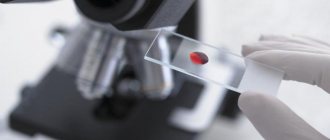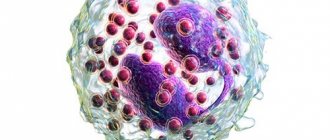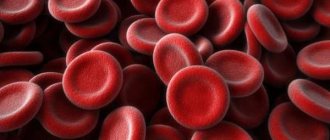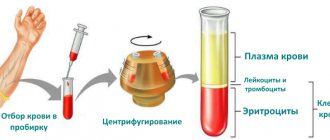At this stage of medical development, various diseases can be confirmed or excluded using a simple blood test. Due to the discovery of many tests, it is difficult to say when and what test to take.
The indication of tumor markers serves to identify and confirm the presence of tumors. Various factors other than tumors affect the test result. You need to know and follow the rules for taking the test. In gynecology, the most important tumor marker for ovarian tumors is CA-125.
Tumor markers and their significance
Tumor markers are specific proteins that are produced by malignant tumors or normal tissues in quantities exceeding the permissible limits due to the entry of cancer cells.
They cannot be used to make an accurate diagnosis, but detection of these substances in the blood and/or urine allows:
- suspect cancer and its location;
- distinguish a malignant tumor from a benign one;
- study the effectiveness of tumor therapy;
- detect relapse of the disease early;
- detect metastases before their clinical manifestation.
Indications for prescribing blood tests for tumor markers
- obtaining information about the presence or absence of a malignant process, along with other examination methods;
- differentiation of a malignant tumor from a benign tumor;
- assessment of the effectiveness of the therapy used;
- monitoring of cancer after treatment for the purpose of early detection of relapses.
The blood of a healthy person contains tumor markers in very small concentrations, since they are produced by some human organs.
At the same time, an increase in the content of tumor markers in the blood does not always indicate the development of a malignant process. Their level may increase slightly in the presence of benign tumors, cysts, inflammatory or infectious diseases, or after colds.
Let's consider blood tests for tumor markers, which have the most important diagnostic value.
Types of tumor markers
Currently, scientists have identified more than 200 types of tumor markers, because all neoplasms secrete their antigens.
The most commonly used tumor markers in diagnostics include:
- Alpha fetoprotein (AFP) is determined to detect liver carcinoma, the formation of metastases of oncological pathologies in other organs and monitor the effectiveness of therapy;
- Carcinoembryonic antigen (CEA) is a protein secreted by embryonic cells; its detection in an adult allows one to detect colorectal cancer with more than 50% accuracy, monitor postoperative relapse, and determine the stage of cancer;
- Human chorionic gonadotropin (hCG) is a marker that increases during pregnancy (it is the increase in the hormone that confirms its presence). If the indicator increases in men and non-pregnant women, testicular or ovarian cancer can be suspected, respectively;
- Prostate specific antigen (PSA ) is a polypeptide, a high level of which allows one to suspect a benign prostate tumor or prostate cancer in a patient;
- CA 15-3 (breast tumor marker) is a highly specific marker that allows you to diagnose breast cancer pathology in the initial stages, evaluate the effectiveness of therapy and identify relapses and metastases in the earliest period;
- CA 19-9 (pancreatic tumor marker ) is a glycoprotein that does not have sufficient specificity, suitable for studying the dynamics of tumor development and differential diagnosis with other formations of the pancreas;
- CA-125 is a specific high-molecular glycoprotein, a tumor marker used in the diagnosis of both ovarian cancer and its metastases;
- HE 4 (epididymal secretory protein) is a glycoprotein, increased production of HE4 has been detected in ovarian and endometrial cancer, rarely in lung adenocarcinoma; has greater sensitivity than CA-125 and is used together with it to confirm the presence of ovarian cancer.
The main reasons for the increase in tumor markers
Normally, every woman has a small volume of CA 125 in her bloodstream. A physiologically acceptable increase can be explained by menstrual flow at the time the woman visited the laboratory. Another situation when the CA 125 norm reaches the upper limits and is not considered something pathological is the first stage of pregnancy.
Pathological deviations in marker parameters lead to:
- pleurisy;
- polycystic ovary syndrome;
- endometriosis;
- pelvic pathologies of an inflammatory nature;
- chronic course of hepatitis, pancreatitis.
In some cases, distortion of information can be observed due to a woman suffering from ARVI or influenza. More often, this situation is caused by existing tumors of the fallopian tubes or mammary gland, as well as a cancerous lesion in the tissues of the stomach.
A thorough history taking in combination with modern diagnostic examinations allows us to finally determine the root cause of high CA125 levels.
What is SA-125?
CA-125, or mucin-16, carbohydrate antigen 125 is an antigen located on the membranes of ovarian cancer cells.
Ovarian tumors represent a serious gynecological problem in all age groups of patients.
In no other human organ is there such a histological diversity of tumors as in the ovaries.
The CA-125 protein belongs to a specific type of epithelium and is normally found in the endometrial tissue of healthy women of reproductive age.
In this situation, changes in CA-125 depend on the phase of the menstrual cycle: a slight increase in its level is observed during menstruation (especially in the presence of endometriosis), as well as during normal pregnancy during the third trimester.
Physiological is the content of CA-125 in the uterine fluid, while it does not penetrate into the bloodstream. Minimal amounts of the glycoprotein can be found in the mesothelial tissues of the thoracic and abdominal organs. Reference (threshold) protein values in laboratory diagnostics are up to 35 U/ml.
Norm
Normally, CA-125 tumor markers are present in every woman’s body, but their quantity should be minimal. When analyzing the CA-125 tumor marker, the norm for women usually does not exceed 15-35 U/ml, however, in women after 40 (sometimes in women after 50 years), as a rule, the level of this antigen can increase to the limit values, or even a little more . Also, slight increases in tumor marker concentrations are possible during menstruation, during acute respiratory viral infections, or in the first trimester of pregnancy.
We recommend reading: What tumor markers for women need to be taken, their norm and explanation
In the table by age compiled by the Ministry of Health, this hormonal antigen does not change its value depending on age, except during menopause, when hormonal changes occur. If the indicators exceed the norm several times, it is necessary to take a blood test several times to monitor the dynamics of the condition. Additional examinations, despite the results of the analysis, will help more accurately identify the presence or absence of oncology.
Who needs to get tested?
- First of all, this test must be taken by every woman who monitors her health. For screening purposes, the analysis is carried out for early detection and most effective treatment of cancer. The sooner an increase in tumor marker levels is detected, the greater the chances of successful treatment of the disease.
- It is important for those women whose relatives have been diagnosed with cancer to undergo the test. For this purpose, it is recommended to carry out the analysis once a year.
- If a woman has previously been diagnosed with benign neoplasms , such as leiomyoma, fibromyoma, functional ovarian cysts, neoplastic lesions, the doctor may prescribe a blood test for tumor markers to diagnose and differentiate tumors.
- It is mandatory for women who have symptoms of a malignant neoplasm to undergo the test. However, do not forget that a positive test for tumor markers is not specific and 100% confirmation of cancer, so additional instrumental research methods (ultrasound, tumor tissue biopsy, MRI) will be prescribed.
- After diagnosing a malignant tumor and carrying out conservative (chemotherapeutic, radiotherapeutic) and surgical (radical removal) treatments, the doctor prescribes repeated blood tests for CA-125 tumor markers. This is done to evaluate the effectiveness of the therapy.
- Subsequent analysis is carried out to identify metastases in distant organs, as well as for the early detection of tumor relapse. To do this, the test is taken monthly in the first year after treatment, then once every 2 months during the second year, and once every 3 months in the third year. In the absence of relapses and metastases, the test is performed 1-2 times a year until the end of the woman’s life.
Could the result be a false positive?
The result of any laboratory test in some cases can be false positive. Its reliability is influenced by both the patient’s own behavior and the poor quality of the clinic’s equipment. The notorious human factor also plays a role.
In order for the differential diagnosis to be as reliable as possible, the specialist, after receiving a blood report for tumor markers, which contradicts the general picture of the pathology and information from other examinations, directs the person to retake the test, for example, to another clinic.
In order to be confident in the high quality of the analysis, you need to properly prepare for blood donation:
- adjust the diet;
- sleep well;
- stop using tobacco and alcohol products;
- the day before, avoid physical and psycho-emotional stress;
- coordinate with the doctor the intake of medications if a person is forced to use them daily;
- come to the laboratory early to have time to rest;
- maintain sexual rest if directed by a doctor.
The likelihood of a false positive result will be minimal if the above preparation rules are followed.
How to take a tumor marker test correctly?
To obtain the most accurate result of a tumor marker test, you need to prepare and adhere to simple but very important rules:
- Blood from a vein must be taken on an empty stomach ; the patient must not eat 8 hours before taking blood for analysis. Only water is allowed among drinks to prevent distortion of results.
- It is better to take the test in the morning , between 8 and 11 o'clock.
- A woman should give up alcohol and smoking at least three days before taking the test.
- Immediately before the test, you need to calm down , because... Nervous strain, along with nicotine and alcohol, can affect the final result.
- For a certain number of days before the analysis, you should not engage in intense physical activity..
- It is necessary to exclude medical procedures (physiotherapy, massages, ultrasound examinations) 3-4 days before the test.
- It is very important to monitor your diet during the week before the test: avoid fatty, fried and spicy foods.
- Consult your doctor about taking medications before the test , because... some of them may affect the result of the analysis.
- If a woman has any inflammatory diseases , the test should be postponed and taken after they are completely eliminated.
- The test cannot be performed during menstruation , because... how this period can be accompanied by a physiological increase in the level of tumor marker in the blood.
If all these rules are followed, the analysis will be clearly and correctly interpreted by the doctor. The result can be expected within 1-2 days after delivery.
Preparation and delivery of tests
You need to take the test in the morning on an empty stomach. Before this, you should not drink alcohol for 3-4 days.
For the same number of days, remove fatty and spicy foods from the menu. Tea, coffee, carbonated drinks and juices are prohibited.
Do not smoke during the day. At the same time, protect yourself from heavy physical work.
The emotional background should be even, calm, stable. Avoid sexual intercourse for five days before blood sampling.
Decoding the results of the CA-125 analysis
After blood is drawn, it is sent to a laboratory where the tumor marker level is determined. After receiving certain numbers, a very important and responsible stage begins - deciphering the results. It requires a high level of professionalism for accurate verification of the diagnosis, and, accordingly, correctly selected treatment for the patient.
Results:
- Threshold values for protein in laboratory diagnostics are up to 35 U/ml.
- Under normal conditions, in the absence of pathology, the tumor marker level fluctuates between 10-15 U/ml.
- An increase in its level to 35 U/ml is observed in women during menstruation, as well as in the first trimester of pregnancy.
- If a woman’s screening examination revealed an increase in the level of the CA-125 tumor marker above 35 U/ml, you should not make hasty conclusions and think about the worst prognosis.
Blood test for marker CA 15-3
The most common form of cancer in women is breast cancer. In addition, breast cancer ranks second among all human cancers.
To diagnose breast cancer, a blood test for CA 15-3 is used. CA 15-3 is a high molecular weight glycoprotein (complex protein) that is a specific tumor marker (antigen) for breast malignancies. The CA 15-3 marker is produced by breast carcinoma cells. This tumor marker has a fairly high specificity. The dynamics of the marker is of greater diagnostic value than its single determination.
A blood test for CA 15-3 is prescribed to monitor ongoing therapy to diagnose metastases and relapses of malignant tumors of the mammary glands.
The normal concentration of this marker in the blood is less than 26.9 U/ml.
An increase in the level of tumor marker CA 15-3 occurs in the following malignant diseases:
- breast carcinoma (especially at a late stage and in the presence of metastases);
- bronchogenic carcinoma;
- pancreas cancer;
- liver and stomach cancer;
- cancer of the uterus, endometrium, ovaries (especially in the later stages).
In addition, an increase in the concentration of the CA 15-3 marker in a blood test may indicate the development of benign breast tumors, liver cirrhosis, hepatitis, and autoimmune diseases.
After therapy, an increased level of this tumor marker indicates the presence of malignant cells in the body. It is also important that relapse of a malignant disease usually begins much later after an increase in the CA 15-3 value.
The diagnostic value of determining this tumor marker increases significantly with the simultaneous determination of another marker - CEA (carcinoembryonic antigen).
Women in the third trimester of pregnancy may have a physiological slight increase in the level of CA 15-3 in the blood.
SA-125 analysis indicators
An increase in the CA-125 antigen in the blood to 100 U/ml can result in various non-tumor processes in a woman’s body:
- inflammatory changes in the abdominal cavity (chronic hepatitis and cirrhosis of the liver, chronic pancreatitis, peritonitis),
- pelvis (pelvioperitonitis),
- cystic ovarian abnormalities,
- endometriosis,
- adnexitis,
- other gynecological infections, pleurisy, autoimmune diseases.
Cystic ovarian abnormality
Ovarian cysts are not true tumors, since in their presence blastomatous (cellular) growth is not observed in the tissues.
They are formed as a result of retention or accumulation of various contents and gland secretions in the cavity. Cysts can form due to tissue softening due to hemorrhage and necrosis.
The presence of cysts in a woman can affect the level of tumor marker CA-125 in the blood, which begins to reach 60-70 U/ml (up to 100 U/ml).
Correct differentiation of ovarian cysts, timely detection, and examination of patients is very important. To accurately confirm the diagnosis, a bimanual examination and ultrasound of the female genital organs are performed.
After a correct diagnosis, the doctor chooses the most appropriate treatment tactics: from conservative and expectant (functional cysts can resolve on their own) to surgical.
Women who have reached the age of menopause require a careful approach. If an elevated level of the CA-125 tumor marker is detected, it is necessary to undergo regular tests to monitor the course of the disease and take the necessary measures.
Endometriosis
This disease is benign and is characterized by the presence of endometrial (tissue inside the uterus) glands and cells outside the uterus.
In 75% of cases, it is observed in women aged 25-50 years, regardless of its location. The incidence of endometriosis in women during the reproductive and later periods averages 10-15%.
The level of tumor marker CA-125 in the blood with this pathology can reach 100 U/ml, which is significantly higher than normal.
Considering the fact that the disease is widespread, it is necessary to carefully differentiate it from malignant neoplasms when an elevated level of CA-125 protein is detected.
A histological examination of the biopsy material, as well as ultrasound data of the female genital organs, can help with this.
It should be remembered that patients with endometriosis are not cured until menopause. Drug therapy is carried out to suppress and reduce endometrioid lesions. For this purpose, properly selected hormonal treatment is used. If indicated, various surgical interventions are performed.
Uterine fibroids
A benign tumor develops from the smooth muscle tissue of the uterus and ranks first in frequency among tumors of the female reproductive system.
According to statistics, 20% of women over the age of 30 have uterine fibroids of various sizes.
The tumor usually does not appear until puberty, develops only during reproductive age and regresses after menopause.
Scientists associate its development with hormonal disorders in a woman’s body.
After the development of this pathology, the level of tumor marker CA-125 in the blood can reach 90-110 U/ml.
To confirm the diagnosis, it is necessary to undergo a bimanual examination and ultrasound of the female genital organs. Only a thorough examination and high professionalism of the doctor will help identify the cause of the increase in tumor markers, as well as take the necessary measures to treat the pathology.
The first step in the management of patients with uterine fibroids is to clarify the shape and growth rate of the tumor. Depending on this, the patient’s treatment tactics are chosen. The main component of conservative treatment is hormonal therapy with progestogens.
In the presence of large tumor sizes and the development of complications from the uterus and adjacent organs, surgical treatment is indicated.
Tumor marker level during pregnancy
In some cases, it is possible to detect elevated levels of CA-125 protein during a normal pregnancy in the first trimester.
This is due to the fact that during this period the female body undergoes significant hormonal changes, general changes in the body, and emotional instability.
Therefore, an increase in the level of CA-125 antigen in the blood is a physiological change. In addition, fetal cells are capable of producing this antigen, as a result of which its level in the blood increases.
Due to the above reasons, the level of CA-125 protein can reach the threshold level of 35 U/ml in the blood and even slightly exceed it. However, this situation only requires careful monitoring of the antigen level and additional examination of the woman. Subsequently, it is mandatory to donate blood again for analysis.
Menopause (menopause)
After menopause (cessation of menstruation), a woman’s body becomes more vulnerable, which is associated with changes in hormonal metabolism.
Detection of an increased level of the CA-125 tumor marker in the blood during this period will no longer be characteristic of pregnancy, menstrual irregularities, endometriosis (the disease regresses) or functional cystic ovarian abnormalities.
Detection of deviations from normal values requires additional research: ultrasound of the female genital organs, bimanual examination, repeated testing for tumor markers in the blood.
If the level of the CA-125 antigen increases and there is no increase in it, the presence of a benign tumor can be assumed. A significant increase, together with symptoms characteristic of the menopausal period (bleeding from the genital tract), will confidently indicate in favor of a malignant neoplasm.
Significance of CA-125 in ovarian cancer
The main purpose of testing for CA-125 in the blood is to laboratory confirm or exclude the presence of a malignant neoplasm in a woman.
In the case of ovarian cancer, the CA-125 antigen level increases more than 5 times compared to the threshold level, thus reaching numbers of more than 100 U/ml. Do not forget that in ovarian cancer the level of the CA-125 antigen may be normal.
This, in turn, should not be regarded as a clear exclusion of cancer. The diagnosis can be established only after conducting a double analysis with increasing indicators over time.
To clarify the diagnosis, if there are controversial indicators of the CA-125 protein, it is useful to take a test for HE-4, which is more sensitive. A combined test with the calculation of a special index makes it possible to identify oncopathology at an early stage, as well as differentiate malignant pelvic tumors from benign ones.
In the early stages of cancer, the CA-125 indicator increases slightly or does not change. As the tumor grows and the stages of the disease progress, its level in the blood may exceed the norm. Testing for this antigen can be used to predict the course of the disease: if the level decreases after starting treatment, patients have a significantly increased survival rate.
It is very important to monitor the woman after treatment in the tumor remission stage. During this period, the level of CA-125 protein is reduced to zero. Increasing it even to a threshold value may mean a relapse even before its clinical manifestation. This condition requires careful examination.
If a constant antigen level is established after the start of treatment, one can judge a poor response to the therapy and continued growth of oncological pathology.
False-positive results when assessing CA-125
Diseases that do not have a tumor origin lead to false-positive results when assessing the level of the CA-125 antigen. They are named as such because the main purpose of the test is to confirm and show the presence of cancer.
These pathologies include:
- inflammatory diseases of the abdominal cavity (peritonitis, chronic hepatitis, chronic pancreatitis);
- pelvic inflammatory diseases (pelvioperitonitis);
- inflammatory diseases of the chest cavity (pleurisy);
- autoimmune diseases;
- infectious lesions of the female genital organs.
Additional examination methods help in differentiating these diseases and oncological pathologies. It is important to promptly confirm and treat, or exclude any damage to internal organs.
Reasons for increasing CA 125
The main reasons for the increase in this tumor marker are malignant neoplasms. CA 125 is elevated when there is a tumor
amazes:
- organs of the female reproductive system (ca125 is the main diagnostic marker of ovarian cancer);
- mammary and pancreas;
- Gastrointestinal tract (stomach and intestines (especially the rectum));
- lung tissue;
- liver (including metastatic lesions).
Among the non-oncological reasons for an increase in tumor marker levels, the following should be highlighted:
- ovarian tumors and cysts of benign origin,
- borderline tumors (low-grade tumors: serous, mucinous, endometrioid, clear cell (mesonephroid) type),
- mixed type tumors
- Brenner's tumor.
Also, an increase in CA 125 can lead to:
- endometriosis,
- severe infectious and inflammatory diseases of the pelvic organs,
- diseases accompanied by serous effusion (pericarditis, pleurisy, etc.),
- chronic hepatitis,
- pancreatitis,
- autoimmune diseases.
What else can the CA-125 tumor marker indicate?
When a high level of protein is initially detected, it is necessary to carry out a qualitative and detailed differential diagnosis with other oncological diseases.
The CA-125 protein is not strictly specific for ovarian cancer; it is also detected in a number of other oncopathologies:
- mammary cancer,
- uterus, endometrium,
- pancreas,
- lungs,
- liver and stomach.
If there are no signs of ovarian cancer on ultrasound, MRI, or histological examination of biopsy material, it is necessary to conduct additional diagnostics of the pathologies of other organs listed above.
Diseases for which a doctor may prescribe a CA 125 test
Lung cancer
A CA 125 level above 100 units/ml may be a sign of lung cancer.
Endometriosis
A CA 125 level between 35 and 100 U/ml may be a symptom of endometriosis.
Peritonitis
A CA 125 level ranging from 35 to 100 units/ml may be a symptom of peritonitis.
Stomach cancer
A CA 125 level above 100 units/ml may be a sign of stomach cancer.
Chronic pancreatitis
A CA 125 level ranging from 35 to 100 units/ml may be a symptom of chronic pancreatitis.
Liver cancer
A CA 125 level above 100 units/ml may be a sign of liver cancer.
Mammary cancer
A CA 125 level above 100 units/ml may be a sign of breast cancer.
Chronic hepatitis
A CA 125 level ranging from 35 to 100 units/ml may be a symptom of chronic hepatitis.
Cirrhosis of the liver
A CA 125 level between 35 and 100 units/ml may be a symptom of liver cirrhosis.
Bottom line
When prescribing an analysis for a tumor marker, a woman must take preparations before it with complete seriousness, otherwise the result and further interpretation may be incorrect.
The following factors may affect the test, so it is worth preparing:
- eating before delivery;
- drinking alcohol and smoking several days in advance;
- drinking coffee, tea before delivery;
- use of medications;
- undergoing ultrasound and x-ray examinations;
- eating spicy, fatty and fried foods;
- stress;
- menstruation.
After eliminating these factors, it remains to correctly decipher the table of analysis results. This requires an excellent specialist and additional research methods. If necessary, the test is repeated.
In addition, an additional analysis for HE-4 may be prescribed. We must not forget that the absence or presence of an increased level of antigen cannot completely exclude or confirm the formation of a malignant tumor.
A timely diagnosis and correctly chosen treatment tactics are the key to an effective and speedy recovery for the patient!











